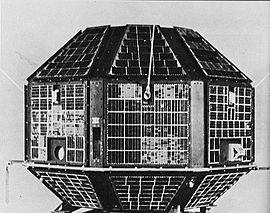Aryabhata (satellite)

India's first indigenously built Satellite launched into Space
|
|
| Mission type | Astrophysics |
|---|---|
| Operator | ISRO |
| COSPAR ID | 1975-033A |
| SATCAT no. | 7752 |
| Mission duration | 4 days achieved |
| Spacecraft properties | |
| Launch mass | 360 kg (794 lb) |
| Power | 46 watts |
| Start of mission | |
| Launch date | 19 April 1975, 07:30 UTC |
| Rocket | Kosmos-3M |
| Launch site | Kapustin Yar 107/2 |
| End of mission | |
| Last contact | 24 April 1975 |
| Decay date | 12 February 1992 |
| Orbital parameters | |
| Reference system | Geocentric |
| Regime | Low Earth |
| Perigee | 568 kilometres (353 mi) |
| Apogee | 611 kilometres (380 mi) |
| Inclination | 50.6 degrees |
| Period | 96.46 minutes |
| Epoch | 19 May 1975 |
Aryabhata (Hindi: आर्यभट्ट) was India's first satellite, named after an Indian astronomer of the same name.
It was launched by India on 19 April 1975 from Kapustin Yar, a Russian rocket launch and development site in Astrakhan Oblast using a Kosmos-3M launch vehicle. It was built by the Indian Space Research Organisation (ISRO) to gain experience in building and operating a satellite in space. The launch came from an agreement between India and the Soviet Union directed by UR Rao and signed in 1972. It allowed the USSR to use Indian ports for tracking ships and launching vessels in return for launching Indian satellites.
On 19 April 1975, the satellite's 96.46-minute orbit had an apogee of 611 kilometres (380 mi) and a perigee of 568 kilometres (353 mi), at an inclination of 50.6 degrees. It was built to conduct experiments in X-ray astronomy, aeronomics, and solar physics. The spacecraft was a 26-sided polyhedron 1.4 metres (4.6 ft) in diameter. All faces (except the top and bottom) were covered with solar cells. A power failure halted experiments after four days and 60 orbits with all signals from the spacecraft lost after five days of operation. According to Soviet media reports, the satellite continued to function and transmit information for some time. The satellite returned to the Earth's atmosphere on 11 February 1992.
...
Wikipedia
